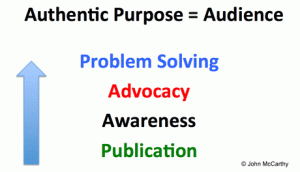4 Paths to Engaging Authentic Purpose and Audience
Give students a face for their audience and let them find the passion in their message through problem solving, advocacy, raising awareness, or publication.
During a coaching session, a teacher team reflected on student engagement. They cited the best example of engagement as when the seniors planned and implemented a fundraiser project for local non-profit organizations. The team agreed with their colleague Melissa Campbell's statement: "The ones who met face to face with their audience displayed genuine excitement for the project and felt the most connection to it."
Authentic purpose and audience offer many opportunities for differentiating the student learning experience. One major challenge for students is that instruction tends to be taught in terms of abstract concepts. In math, percentages and equations are generally taught first as abstract logical operations rather than as ways to understand sales and tipping, or budgets on spreadsheets. Writing is likely taught as sequencing sentences into paragraphs that comprise fiction and non-fiction, such as the five-paragraph approach, instead of focusing on convincing others to donate money or time for a social cause through published essays, editorials, and scripted infomercials. We seem stuck in this view that we must teach the skills first and provide context later. Yet when we are charged with implementing new initiatives like Response to Intervention, guided reading (as in this video), or STEAM, we expect -- and rightly so -- to be told the purpose and value for our students and for our professional practice. Before working on skills, we want context. So why shouldn't we expect that students require the same?
Differentiation helps to make learning outcomes contextual to students' lives. Because they have diverse background experiences, context should be provided and explored through a variety of ways. When done effectively, the process of differentiating fits seamlessly with excellent instruction.
Give Students a Face for the Audience
Students tend to view curriculum outcomes like abstract art: "There's something on the canvas, but I've no clear idea of what 'it' is." Learners need context for how outcomes connect content to their lives -- but that's not always viewed as possible, or necessarily the best idea. A face for the audience gives students a real person or organization (via their representative) for asking questions, receiving feedback, and proposing ideas. Steven Levy discusses this in The Power of Audience. From a differentiation perspective, working with such people or organizations opens many opportunities to provide support based on learners' readiness, interests, and/or learning profile.
Authentic Purpose = Audience
A strategy to finding such an audience is an authentic purpose lens used during planning. Based on the unit outcomes, ask yourself: "If students learn the outcomes by the end of the unit, how could they apply them for an audience?"
Test the answer to the question through the following lens to find the best fit:

Problem Solving
The news is filled with problems to be solved. There are many issues -- locally and nationally -- on which students can weigh in from their unique perspective. Their strength is that they are free of the social politics that often cause solution paralysis in adult thinking. When students seek a solution to a problem, they use a variety of viewpoints individually and in groups. Because these viewpoints represent a variety of learning profiles at once, such as visual and introspective (Gardner) or practical and analytical (Sternberg), this can lead to creative and innovative ideas.
Advocacy
Convincing others to take action is a natural fit for social and justice issues. There are organizations that stand for different points of view. Tapping interests, students can find a topic about which they're passionate and therefore motivated to slog toward understanding complex concepts and content. Without advocacy opportunities, some portion of students will more likely quit in the face of one-size-fits-all instructional approaches.
Awareness
Educating an audience about a community issue or national need is a way for students to contribute their voices. Interests and learning profiles can be used in this area, yet there is a great opportunity for using students' readiness to address the depth of complexity at various levels while still providing genuine voice to contribute to a community need. For example, place students into leveled teams so that they can educate the adult community or a younger grade level on global warming or the practical applications of percentages (restaurant tipping or sales coupons). Or in heterogeneous teams, students might address the same topics at each level of complexity so as to differentiate for their audience's diverse readiness.
Publication
Sometimes, educators struggle to connect content and concepts with problem solving, advocacy, or awareness. In those instances, publish student work online. The audience may be partly academics, partly people in the field, and partly students from other schools who study similar work. Differentiation can be addressed by readiness based on academic support needs, interests where applicable to the content (this could be difficult with truly abstract concepts), and/or learning profile through a variety of different product formats. Some easy resources to use are blogs, wikis, and Google apps. Here are 50+ social media tools to consider as options. (Note: prior to publication, be sure to verify your school and district guidelines for internet protection of children's identity.)
Link Audience to Purpose
Once the purpose is identified from this list of four, an audience becomes easier to identify. If the problem to solve is developing an effective marketing plan for local businesses, then you identify those businesses in the community. If advocating for an issue leads to a fund-raising event, then we look for a cause, such as children with cancer. Raising awareness about healthy eating may lead to an audience that includes the school food service, parents, and peers. Publication online leads to advertising via social media or other communication tools. Once the audience is tangible -- as someone with whom students interact -- learners are more likely to work with you as learning becomes contextual. The support possibilities and opportunities become endless.
Which lens could you start using?
